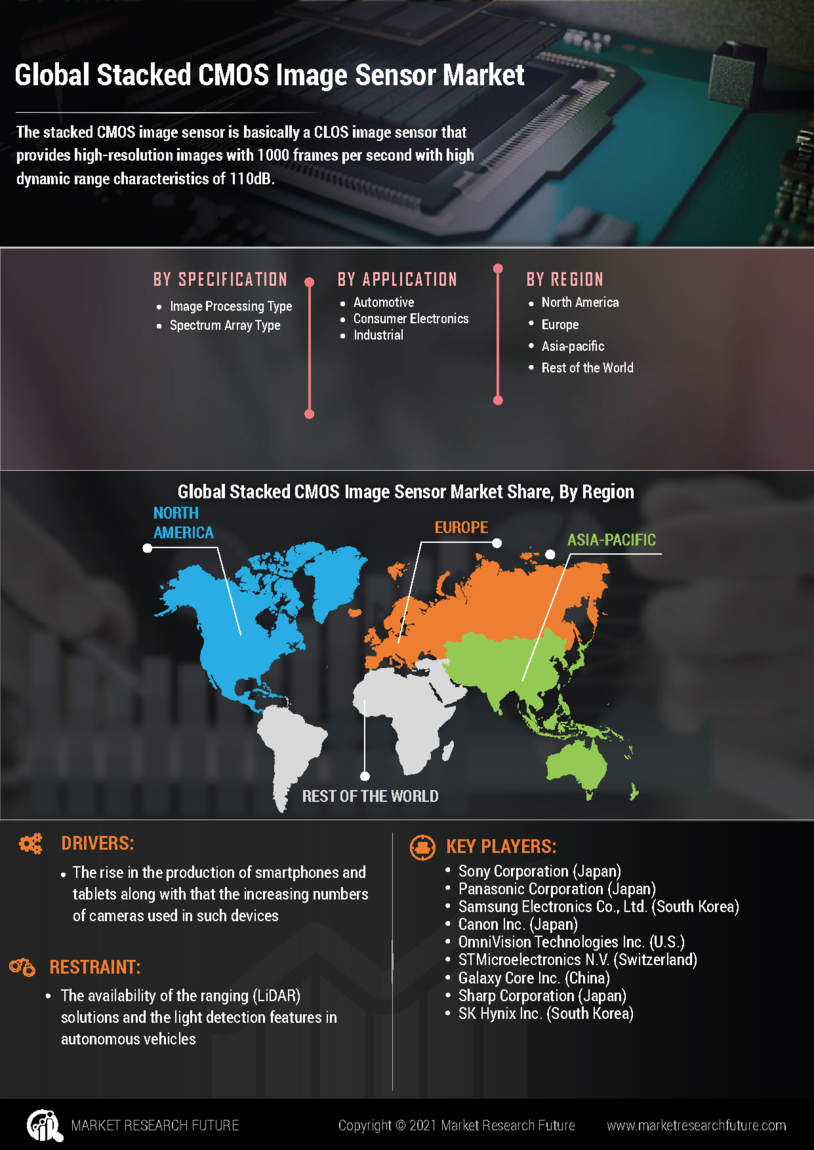Emergence of Smart Home Devices
The Stacked CMOS Image Sensor Market is also benefiting from the emergence of smart home devices, which increasingly rely on advanced imaging technologies. As consumers seek to enhance their home security and automation systems, the demand for high-performance image sensors in devices such as smart cameras and doorbell cameras is growing. Market analysis indicates that the smart home segment is expected to witness a compound annual growth rate (CAGR) of over 25% in the coming years. This trend suggests that manufacturers in the Stacked CMOS Image Sensor Market will need to focus on developing compact, efficient, and high-quality imaging solutions to cater to the expanding smart home market.
Advancements in Mobile Technology
The Stacked CMOS Image Sensor Market is significantly influenced by advancements in mobile technology. The continuous evolution of smartphones and tablets, which increasingly incorporate sophisticated imaging capabilities, has propelled the demand for stacked CMOS image sensors. As mobile devices become central to daily life, the need for enhanced imaging features, such as improved low-light performance and faster autofocus, has become paramount. Market data suggests that the smartphone segment alone accounts for over 50% of the total image sensor market, underscoring the critical role of mobile technology in driving growth within the Stacked CMOS Image Sensor Market. This trend is expected to persist as manufacturers innovate to deliver cutting-edge imaging solutions.
Growth in Automotive Applications
The Stacked CMOS Image Sensor Market is witnessing substantial growth due to the increasing integration of imaging technologies in automotive applications. As vehicles become more advanced, the demand for high-quality imaging systems for safety features, such as rearview cameras and advanced driver-assistance systems (ADAS), is on the rise. Recent statistics indicate that the automotive sector is projected to account for approximately 20% of the total image sensor market by 2025. This shift towards enhanced safety and automation in vehicles is likely to drive further investments in stacked CMOS image sensors, as manufacturers seek to develop innovative solutions that meet the evolving needs of the automotive industry.
Rising Demand for High-Resolution Imaging
The Stacked CMOS Image Sensor Market is experiencing a notable surge in demand for high-resolution imaging solutions. This trend is primarily driven by the increasing adoption of advanced imaging technologies in sectors such as consumer electronics, automotive, and healthcare. For instance, the proliferation of smartphones equipped with high-resolution cameras has significantly contributed to the growth of this market segment. According to recent data, the demand for image sensors is projected to reach approximately 10 billion units by 2026, indicating a robust growth trajectory. As manufacturers strive to meet consumer expectations for superior image quality, the Stacked CMOS Image Sensor Market is likely to witness further innovations in sensor design and performance.
Increased Investment in Surveillance Systems
The Stacked CMOS Image Sensor Market is experiencing a boost from increased investment in surveillance systems across various sectors. The growing emphasis on security and safety has led to a heightened demand for high-resolution imaging solutions in both public and private sectors. Recent data indicates that The Stacked CMOS Image Sensor Market is projected to reach USD 75 billion by 2025, with a significant portion of this growth attributed to advancements in imaging technology. As organizations prioritize security measures, the need for high-quality stacked CMOS image sensors in surveillance cameras is likely to rise, further propelling the growth of the Stacked CMOS Image Sensor Market.

















Leave a Comment